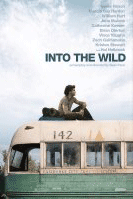
At 22, Sean Penn became a cult icon. As Jeff Spicoli, the perpetually stoned surfer dude in Fast Times at Ridgemont High, Penn’s comic insouciance captured a generation yearning for rebellion. Now, 25 years and a helping of Oscar credibility later, Penn has stepped behind the camera to examine another young American icon with his film Into the Wild.
Into the Wild chronicles the journey of Christopher McCandless, who at age 22 left behind his affluent family in 1990, donated his savings to Oxfam, burned his social security card, and eventually starved to death in the Alaskan wilderness, the tragic finale to a long romance with North America’s wild places. In 1996, outdoors writer Jon Krakauer published the story of McCandless’ short life and baffling death in Into the Wild. The book ensured McCandless’ cult status: What Spicoli was for stoned surfer dudes, McCandless became for anyone who looked to nature as an escape from the spiritual pollution of society. McCandless’ premature demise only strengthened his appeal.
Upon graduating from Emory University, McCandless headed west in a beat-up Datsun. He had no fixed itinerary, only an intense longing for experience and self-discovery. After abandoning his car in the Arizona desert, he alternately walked, kayaked, and hitchhiked into Mexico and then throughout the American West working odd jobs and forming intimate friendships that he swiftly broke off. McCandless’ sights were set on Alaska, which he hoped would be both a proving ground and a place of purification. The letters he sent to friends and the journal he kept do not reveal suicidal tendencies; McCandless seems to have had little notion that his beloved, idealized Alaska would be his last adventure. And yet in his recklessness and voluntary isolation, McCandless displayed a remarkable capacity for self-destruction.
It’s likely that Penn, whose hobbies include railing against the war in Iraq, saw a kindred spirit in the restless McCandless. McCandless’ rejection of a prosperous, corrupt society has an obvious analog in Penn’s well-known political beliefs. McCandless flees his parents’ materialism and sham marriage; Penn calls for George W. Bush to be fired and put in jail.
Though McCandless’ life did have some exemplary aspects, Penn’s version of it comes a bit close to hagiography. Emile Hirsch, whose previous incarnations tended to fall somewhere between plucky and wicked (Emperor’s Club, Dangerous Lives of Altar Boys, Alpha Dog), oozes with goodness as McCandless. He plays wounded but luminous well, and you can see why the various loners he meets on his long road trip want to adopt him—though only Hal Holbrook, playing a broken-down retiree, offers to make it legal. With his pretty face and vague idealism passing for charisma, Hirsch even upstages the gorgeous landscapes around him, and perhaps this is as it should be. McCandless’ journey, after all, was never as much about nature itself as it was about using nature as a place to find or lose himself.
It seems odd, though, that the destructive power of nature, which gives terrific momentum to Krakauer’s book, is largely absent from the movie version. Drowned out by Eddie Vedder’s rapturous soundtrack and irradiated by Hirsch’s megawatt smile, McCandless’ savage death isn’t an organizing principle so much as a special lamp designed to cast the proper amount of melancholy. What anger and melancholy the movie has originates in and flows back to the evils of society embodied by the hypocritical Mr. and Mrs. McCandless (played by William Hurt and Marcia Gay Harden). Bereft by their son’s disappearance, they also appear as responsible for it.
Penn doesn’t address Chris McCandless’ responsibility for his own death, as Krakauer does in the book. It wouldn’t fit in this bright-eyed tribute to youth and the boldness and spontaneity youth inspires—with fleeting nods to the beauty of nature. Penn’s politics are condemnatory, but his filmmaking style, at least in Into the Wild, is all joyous homage. Given that the film’s ostensible subject is a young man’s terribly unnecessary death, its exuberance is resoundingly odd. It seems as though Chris’ life, over before he was 25 in spite of all his talents, ought to inspire pity rather than admiration. Then again, it may be this dissonance that makes his story so compelling.












